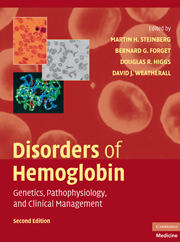Book contents
- Frontmatter
- Contents
- List of Contributors
- Foreword, by H. Franklin Bunn
- Preface
- Introduction, by David J. Weatherall
- SECTION ONE THE MOLECULAR, CELLULAR, AND GENETIC BASIS OF HEMOGLOBIN DISORDERS
- 1 A Developmental Approach to Hematopoiesis
- 2 Erythropoiesis
- 3 The Normal Structure and Regulation of Human Globin Gene Clusters
- 4 Nuclear Factors That Regulate Erythropoiesis
- 5 Molecular and Cellular Basis of Hemoglobin Switching
- 6 Structure and Function of Hemoglobin and Its Dysfunction in Sickle Cell Disease
- 7 Hemoglobins of the Embryo, Fetus, and Adult
- SECTION TWO PATHOPHYSIOLOGY OF HEMOGLOBIN AND ITS DISORDERS
- SECTION THREE α THALASSEMIA
- SECTION FOUR THE β THALASSEMIAS
- SECTION FIVE SICKLE CELL DISEASE
- SECTION SIX OTHER CLINICALLY IMPORTANT DISORDERS OF HEMOGLOBIN
- SECTION SEVEN SPECIAL TOPICS IN HEMOGLOBINOPATHIES
- SECTION EIGHT NEW APPROACHES TO THE TREATMENT OF HEMOGLOBINOPATHIES AND THALASSEMIA
- Index
- Plate section
- References
2 - Erythropoiesis
from SECTION ONE - THE MOLECULAR, CELLULAR, AND GENETIC BASIS OF HEMOGLOBIN DISORDERS
Published online by Cambridge University Press: 03 May 2010
- Frontmatter
- Contents
- List of Contributors
- Foreword, by H. Franklin Bunn
- Preface
- Introduction, by David J. Weatherall
- SECTION ONE THE MOLECULAR, CELLULAR, AND GENETIC BASIS OF HEMOGLOBIN DISORDERS
- 1 A Developmental Approach to Hematopoiesis
- 2 Erythropoiesis
- 3 The Normal Structure and Regulation of Human Globin Gene Clusters
- 4 Nuclear Factors That Regulate Erythropoiesis
- 5 Molecular and Cellular Basis of Hemoglobin Switching
- 6 Structure and Function of Hemoglobin and Its Dysfunction in Sickle Cell Disease
- 7 Hemoglobins of the Embryo, Fetus, and Adult
- SECTION TWO PATHOPHYSIOLOGY OF HEMOGLOBIN AND ITS DISORDERS
- SECTION THREE α THALASSEMIA
- SECTION FOUR THE β THALASSEMIAS
- SECTION FIVE SICKLE CELL DISEASE
- SECTION SIX OTHER CLINICALLY IMPORTANT DISORDERS OF HEMOGLOBIN
- SECTION SEVEN SPECIAL TOPICS IN HEMOGLOBINOPATHIES
- SECTION EIGHT NEW APPROACHES TO THE TREATMENT OF HEMOGLOBINOPATHIES AND THALASSEMIA
- Index
- Plate section
- References
Summary
INTRODUCTION
Erythropoiesis involves the production of mature enucleated erythrocytes from committed erythroid progenitor cells, which in turn are derived from multilineage progenitors and ultimately from the hematopoietic stem cell (HSC). In human the mature erythrocytes turn over at a rate of approximately 1% per day and it can be estimated that maintaining the red blood cell count in an adult requires approximately 2.4 × 106 new erythrocytes to be produced each second. It is not surprising, therefore, that the regulation of erythropoiesis is a complex, multifaceted process that has to cope with not only maintaining the steady state but also with providing reserves to cope rapidly with increased demand as a result of physiological or pathological demands. In this chapter we will consider the developmental origins of red cell production, their differentiation from HSCs as well as production of the hormone erythropoietin. We will examine how erythropoietin responds to tissue hypoxia and exerts its effect through cell surface receptors on erythroid cells to trigger a number of cell signaling cascades to maintain, through critical transcription factors, the survival, proliferation, and maturation of the erythron.
ERYTHROPOIESIS DURING DEVELOPMENT
The first erythrocytes appearing during vertebrate development are known as primitive erythrocytes. These cells are produced by a transient first wave of hematopoiesis, which is almost entirely dedicated to the production of primitive red cells. Primitive erythropoiesis has been studied in evolutionary distant vertebrates, in particular in fish, amphibians, birds, and mammals.
- Type
- Chapter
- Information
- Disorders of HemoglobinGenetics, Pathophysiology, and Clinical Management, pp. 24 - 45Publisher: Cambridge University PressPrint publication year: 2009
References
- 1
- Cited by



